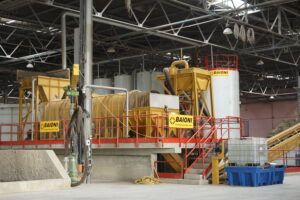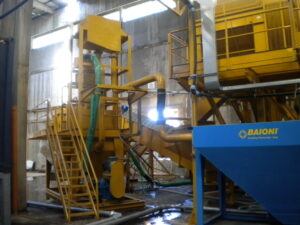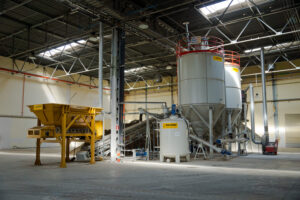Soil washing: washing systems for contaminated soils
Soils are frequently degraded and polluted and therefore present risks for both the environment and the general population. Contaminated mainly by heavy metals (lead, arsenic, copper, etc.) and organic compounds (hydrocarbons, methane, etc.), polluted soils can affect groundwater, surface water and the human body through the skin, by ingestion – for example by eating plants grown on these soils – and by inhaling particles.
What can we do?
Beside the world’s political decisions to reduce global warming, Baioni as an industrial operator also has a duty to save the environment, and it does so by offering a highly innovative solution.
Soil Washing.
What is soil washing?
It is an effective technique for the remediation of contaminated soils aiming at recovering the valuable part through a process of physical separation of the pollutant herein, which results in a multi-stage process aimed at reclaiming, i.e. washing the ‘dirty’ soil by separating it permanently from the pollutant.
Baioni deals with this technique, it has developed its own process technology offering real complete solutions that can be feasible based on the type of contamination and the final use of the recovered soil.
Baioni is able to undertake large scale soil washing processes by developing its own process technology offering effective complete solutions that can be feasible based on the type of contamination and the final use of the recovered soil.
SW takes advantage of the tendency of most organic and inorganic materials to absorb onto the surfaces of the smaller particles contained in soils, i.e. onto clays, silt and the organic content. In turn, these finer fractions adhere to sand and gravel. The washing process breaks up these aggregates and allows to concentrate the contaminants in a smaller volume composed of the above mentioned fine fractions, recovering a large portion of the matrix material which would otherwise be disposed. Hence, soil washing results in a significant reduction in the volume of contaminated soil.
Who is this technique intended for? What is the application field?
It is certainly the environmental remediation industry, in a general sense, where it is necessary or mandatory to separate and clean contaminated soils, thus allowing the recovery of the inert fraction with coarse granulometry (sands and gravels):
• Contaminated site remediation after industry relocation Emergency remediation of site polluted by accidents
• Remediation of industrial contaminated site in operation
• Environmental restoration of river or sea sediments
• Environmental restoration of mining zones
• Remediation and reconstruction of landfill and temporary storage sites
The soil washing plants designed, manufactured and commissioned by the Environment Division of Baioni are effective in removing the polluting part of the soil as they are able to wash, screen out and recycle materials coming from quarries, mines or C&D recycling sites.
Each plant is made to measure based on the characterization of the soil to be reclaimed and with the aim of providing the best technical and economic solution. Each plant is a real project that requires an intense and integrated approach, combining civil engineering, hydrogeology and environmental technology to identify the best plant combination.
How does soil washing work?
Various stage processes
•Excavation of the soil and storage of contaminated soil
•Initial screening with dosing hopper
•Preliminary screening and possible crushing
•First washing of the material with a drum slurry machine or a vane and screen slurry machine
•Cycloning of the material with fine recovery group
•Friction of the material by means of friction cells
•Further sand washing cycle with second hydrocyclone
•Further washing of the gravels by means of a receiver
•Mechanical dehydration of sludge
Advantages:
Of course many. And all of them meet the remediation targets required by government agencies:
•volume of subject contaminants can be reduced significantly
•no off-gas or waste water discharges from the system during treatment
•one of the few permanent treatment alternatives for soils contaminated with metals
•the washing reagent can be clean water or chemical reagents
•soil can be backfilled post-remediation depending upon site conditions
•huge reduction in the volume of heavy traffic (i.e. to transport large volumes of material to landfill)
The main advantage of soil washing is that it is a cost-effective technique because it reduces the amount of the material that would require further treatment by another technology.
There has been a great deal of interest in the soil washing equipment being applied in Italy, also from officers and representatives of many Local Authorities. Hopefully this level of interest in sustainable solutions will lead to their increased use in the future.
 |  |  |
